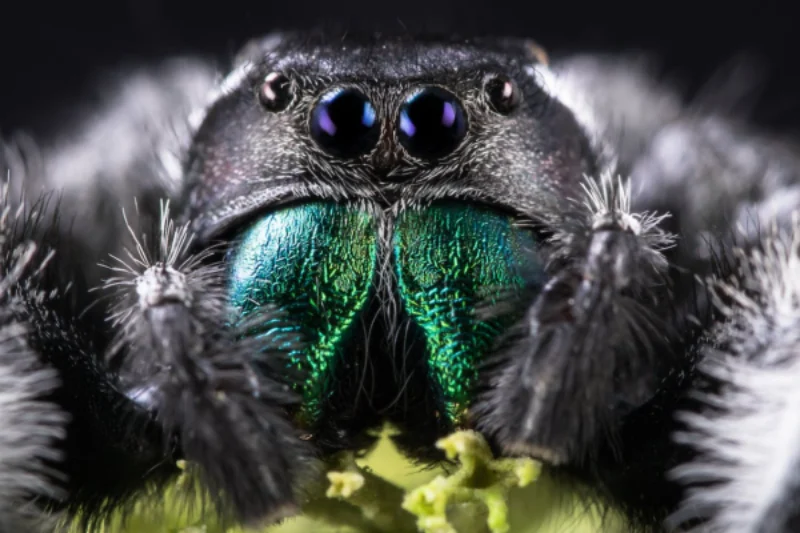Spiders are such prevalent and frightening critters that you just want to kick them out of the house or anywhere you encounter them. They are not as creepy as we think about them, but if we look at them very closely with curiosity, we will get attracted to them.
There are so many varieties of spiders in this world that we don’t even know. You’ve probably heard of a number of different spiders, but today I’m going to talk about the Purple Gold Jumping Spider Wiki.
This enchanting spider species is known for its vibrant coloration and incredible behavior. I was really amazed to see how different they are from other spiders, whether in terms of hues or features.
So let’s explore their little world, which is full of fascinating things like its physical features, habitat, hunting techniques, and remarkable life cycle. So let’s start this extraordinary journey.
Purple-gold Jumping Spider (Irura bidenticulata): Wiki
Irura bidenticulata is commonly known as the Purple gold jumping spider, which they got because of their striking appearance. These spiders are members of the Salticidae family. So, to begin, consider the following:
| Scientific name | Irura bidenticulata |
| Common name | Purple gold jumping spider |
| Size | 5–6 mm (0.20–0.24 in) |
| Habitat | Vegetation, wood piles, rocky habitats, and buildings |
| Diet | Insects and small spiders |
| Predators | Birds, Reptiles, Mammals, and wasps |
| Colors | Metallic purple coloration with golden markings |
| Weight | No information |
| Life span | 6 months to 2 years |
| About it | Considered not harmful to humans, have shiny metallic purple and golden body coloration |
I. Appearance of Purple-gold Jumping Spider
Let’s start with the appearance of this purple-gold jumping spider, scientifically known as Irura bidenticulata, which exhibits incredible iridescent hues.
They exhibit dramatic sexual dimorphism. Females tend to be duller in color as compared to males. Females of this spider species show solid gold coloration with brown markings, which is totally different from males, which exhibit remarkable purple hues with golden patterns.
Males with this dazzling coloration look like snow angels wearing top hats, which are surrounded by the golden markings.
This small creature, ranging in size from 5 to 6 mm, is coupled with its distinct color, which makes it a remarkable sight in nature.
II. Purple gold jumping spider: Geolocation and Habitat
The purple-gold jumping spider can be found in diverse regions across Southeast Asia. Like other jumping spiders, these spiders also inhabit vegetation, wood piles, rocky habitats, and buildings.
In 2011, researchers discovered the first purple gold jumping spider in Hainan, China. It demonstrates its tremendous perseverance and suitability for its surroundings.
The number of these spiders in a particular habitat depends on the abundance of their prey, including insects, other arthropods, and small spiders.
III. Purple gold jumping spider: Role in the ecosystem
Like any other organism, the purple gold jumping spider plays a very important role in the environment and contributes in different ways to the ecosystem.
They serve the ecology by preying on insects, tiny spiders, and other arthropods, and numerous birds, reptiles, mammals, and wasps consume them. They are also the pollinators of different flowers in their native region, which makes them an important part of it.
The majority of spiders are advantageous to humans and are indicators of biodiversity and environmental health.
IV. Some interesting facts about it
Apart from their coloration, their vision is also stunning. These spiders have four pairs of eyes, which they use to visualize their prey and their courtship dance moves.
Like any other common spider, they don’t use webs to trap their prey; instead, they directly jump on their prey.
They don’t usually construct webs, but they do produce silk for other purposes, like creating shelter and draglines while moving around.
The brighter the colors, the more appealing they are. Males of this species are extremely vivid, with a metallic purple gloss and golden patterns. Females were drawn to guys with brighter colors.
Similar spider Species
Simaetha sp.
Australasia is home to these purple-gold jumping spider twins. Not just their common name, these spiders share a huge similarity in their appearance.
They appear so similar that they were initially classified as belonging to the Simaetha genus.
Also exhibits vibrant purple and gold coloration. They are also, just like them, small in size with a large abdomen and eight legs, but they do not exhibit sexual dimorphism as Irura bidenticulata does.
Apart from their commonalities, they have several characteristics that distinguish them. There is much to learn about these species; perhaps they have some survival benefits due to their comparable shape.
Conclusion:
This brings us to the end of our discussion of the purple-gold jumping spider. The purple-gold jumping spider is a beautiful and intriguing creature that is well-adapted to its environment.
In this article, we discussed not only this species but also the species that are similar to it. The world of these spiders is really fascinating and intriguing, which draws us in.
I hope you find this information interesting. I’ll be back shortly with another intriguing story. Until then, enjoy these spiders.
Frequently Asked Questions:
Q1) What is a purple-gold jumping spider?
Ans. Purple-gold jumping spiders (Irura bidenticulata) belong to the family Salticidae and have striking metallic purple and gold coloration, which makes them stand out in the crowd.
Q2) Are purple-gold jumping spiders dangerous or venomous?
Ans. Though purple gold-jumping spiders, like every spider species, are venomous, their venom is not that powerful to harm humans.
Q3) What are purple spiders?
Ans. There are many purple spiders that exist in nature, like the Purple tree tarantula, the Antilles pink toe tarantula, the Madagascar hermit spider, etc.
Q4) What is the largest spider in the world?
Ans. Theraphosa blondi, commonly known as the Goliath birdeater, is the largest spider in the world and is found in northern South America.
Q5) Are daddy long-leg spiders?
Ans. Daddy Longlegs, or Harvestman, are not true spiders.
Q6) How do these purple-gold jumping spiders communicate?
Ans. These spiders communicate through vibrations, visual displays, and chemical signals.
Featured Image Credit: Michael Willinger (@Pixels)
Also Read:

Being a zoology student I’m always been fascinated toward animals especially insects. I love to do research and learn about different animals. As a writer I want to share my thoughts about nature through my articles. Apart from this you can find me exploring the new places and voice notes.
